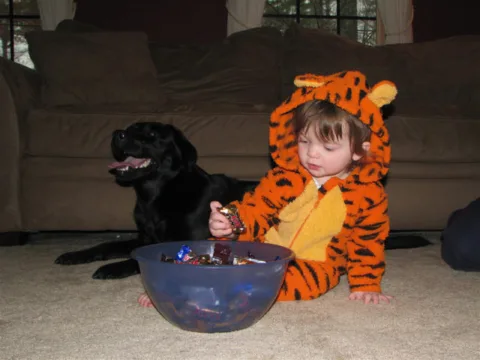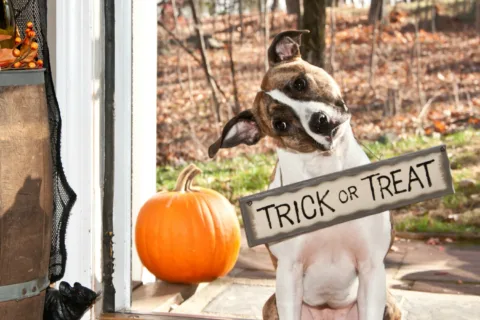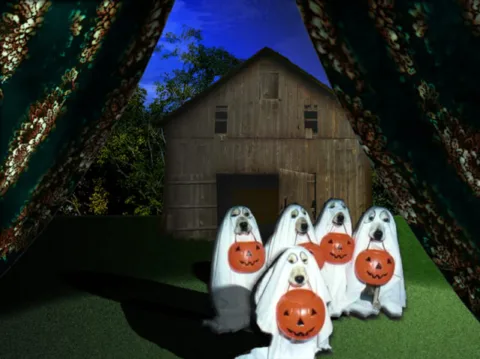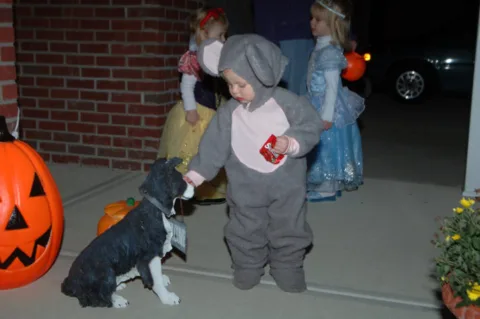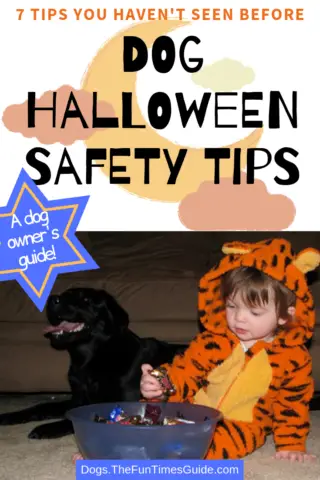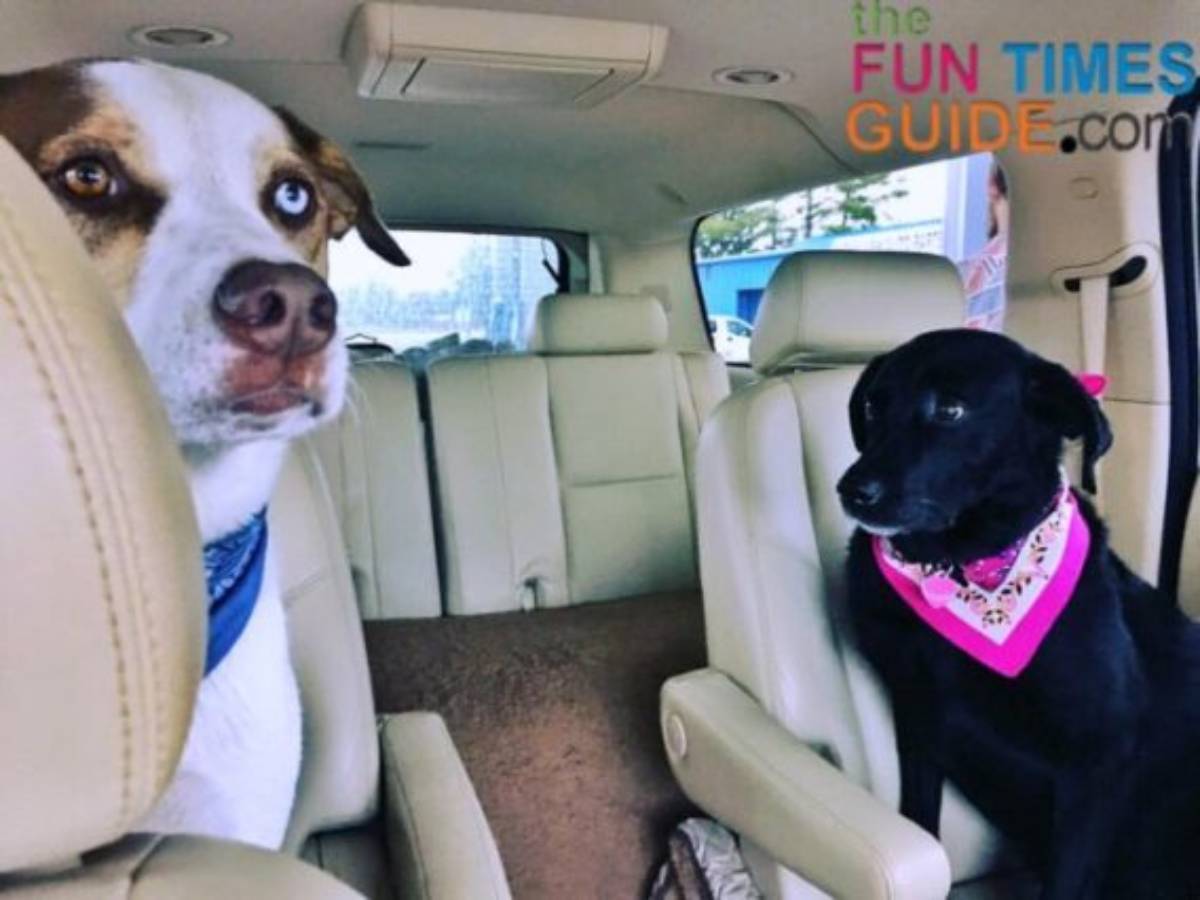There are a lot of fun Halloween things for kids to do in October — especially on Halloween night. Kids love to dress up and go trick-or-treating.
Parents have fun too — they love seeing their little ones in costume and safely watch over them as they go door to door. Of course, adults enjoy Halloween costume parties, as well.
But what about your dog? How much fun is Halloween for dogs?
Dog stress is a serious issue. You won’t want your dog to be stressed during Halloween — or during any holiday for that matter.
Following are 7 must-see tips for keeping your dog safe and happy on Halloween night:
- How to adjust your dog’s normal routine to accommodate the Halloween trick-or-treaters that will be ringing the doorbell soon after dinner.
- How to keep your dog calm and prevent vomiting, diarrhea, submissive urination, or even canine aggression on Halloween night.
- The #1 thing you should do to keep your dog safe in case he slips out the door when trick-or-treaters arrive.
- What you need to know about dogs and chocolate… and how much chocolate is too much for a dog.
- How to prevent your normally friendly dog from biting a child or stranger while trick-or-treating or attending a Halloween party.
- What to look for to ensure that your dog isn’t too stressed out… IF you decide to dress your dog in a Halloween costume.
- How to puppyproof your Halloween decorations to keep your dog safe at home.
7 Dog Halloween Safety Tips
According to the American Humane Society, incidents of dogs being poisoned after eating candy increase substantially during Halloween.
Keep in mind, your dog is part of your family and you are his pack. He trusts you to keep him safe — you are his Alpha dog.
Of course, you wouldn’t want your dog to become ill or injured due to your own negligence. That’s one of the reasons the American Humane Society recommends keeping your dog indoors and away from the commotion on Halloween night — to prevent your dog from becoming frightened, stressed, or injured.
Here are some important things to keep in mind:
#1 – Be sure to take your dog out to pee and poop before spooks and ghouls begin constantly ringing your doorbell right after dinner.
As the sun sets on Halloween, attach your dog to you using a waist leash. This allows you to have your hands free to hand out candy (and controlling your dog if necessary) while limiting your dog’s movement toward strangers. If possible, exercise your dog’s mind and body a few hours before trick-or-treaters arrive. Your goal is to tire out your dog. If you are unable to take your dog on a vigorous walk and then play some fun doggy mental games, consider hiring a professional dog walker or pet sitter to be your proxy for that afternoon. ~Pets Best
#2 – Strangers in spooky costumes will be coming to your door for hours. This can be confusing for your dog and lead to vomiting, diarrhea or even submissive urination. An otherwise docile pet may even experience canine aggression on Halloween from all the excitement.
The first step is to keep your dog as comfortable as possible – away from windows and the front door, in a quiet area where he can have a nice something to chew on. Here are 6 other things you can try. ~Dogs Naturally
#3 – Any open door gives your dog an opportunity to escape. On Halloween night, make sure that your dog is wearing a collar and ID tags, just in case he slips away momentarily or escapes and becomes lost. Many pets are lost on Halloween night — don’t let this happen to your dog!
The SPCA reports that the day after Halloween is the busiest day for lost dogs and cats to arrive at the shelters. Just think how strange it must be for a pet to hear the doorbell ringing constantly and see very strange human like bodies shouting “Trick or Treat!” ~Southside Place Animal Hospital
#4 – Keep all forms of candy out of your dog’s reach. Candy (especially chocolate) is toxic to dogs — because they don’t have the stomach enzymes to digest it. The amount of chocolate that’s dangerous depends on the size of your dog. Don’t allow your dog to become a statistic — have your dog’s favorite treats on hand, or give him a filled Kong toy, or make these homemade dog Halloween treats.
Of all candy, chocolate is one of the most toxic to pets. Over the past year, more than 1,100 calls to Pet Poison Helpline involved exposure to chocolate and 98% of them involved dogs. To avoid issues, keep Halloween candy well out of the reach of pets at all times. If you think your pet may have ingested chocolate, symptoms to watch for include vomiting, diarrhea, lethargy, agitation, increased thirst, an elevated heart rate, and in severe cases, seizures. ~Pet Poison Hotline
#5 – Don’t send your dog out trick-or-treating with your kids. That’s a parent’s job, not a child’s job. Young children aren’t capable of caring for a dog when spooky ghosts and goblins are flooding the streets. If your dog gets loose and becomes confused, frightened, or disoriented… he may even bite out of fear. Dog bites are serious and all dogs who bite are looked upon as a threat — in the neighborhood.
Halloween’s sights and sounds are unlike any other time of the year. People come in and out of homes in scary costumes. There are a lot of loud voices, doorbells, and commotion. Frightening decorations are everywhere — some with strobe lights or artificial fog. Because there is so much going on, dogs can react in ways they never have before. Common reasons that a dog will bite:
- An instinct to protect the dog’s owner or the owner’s property
- Confusion or fear due to unknown visitors, sights, or sounds
- Aggravation from hugging, poking, waving hands in the dog’s face, or pulling its fur, tail, ears
- Injury or sickness
#6 – Think twice before dressing your dog in a pet Halloween costume. These are often uncomfortable for dogs — not to mention the fact that elastic can become twisted in the dog’s fur and cause swelling. Your dog may decide to chew on the costume, and he may even eat parts of it. This could lead to an intestinal blockage, in addition to the pure stress he’s already going through on Halloween night.
Your safest choice in a pet Halloween costume would be a loosely tied bandana; however, if you choose to dress up your pet, outfit your dog or cat with a simple approach. Pets can become tangled in elaborate, tight-fitting costumes with strings, ties, belts and sashes. Difficulty in mobility can lead to bodily injury, including strangulation. Never leave a pet unattended while wearing a costume. Small (or large) parts of a costume can become chewed and ingested and can in turn potentially lead to foreign body ingestion which can be life threatening to your pet. ~Pet Health Zone
#7 – Puppyproof your house to keep Halloween decorations, electrical cords, homemade spider webs, and streamers hidden and out of reach from your dog. Chewing on these can cause dogs to become seriously ill (or even die). Things like streamers and spider webs can choke off the intestines — and if your dog chews on electrical cords, he may become electrocuted.
If you have candles or votives as part of your decorations, make sure the lighted candles are out of “tail range”. Although most candles on Halloween are used to light up the inside of a pumpkin, that doesn’t mean it’s completely free of danger! A swiping dog tail could easily knock a candle over, and a very excited pup can roll over a pumpkin, sending the candle flying and lighting everything in its path. ~Vet Depot
The Bottom Line
It’s up to you to do everything you can to keep your dog safe this Halloween.
Use the tips in this article (and your own common sense) to ensure that you and your dog have a safe and happy Halloween!
Because you can never be too prepared…
Like this post? Save it to read again later… or share with others on Pinterest!

